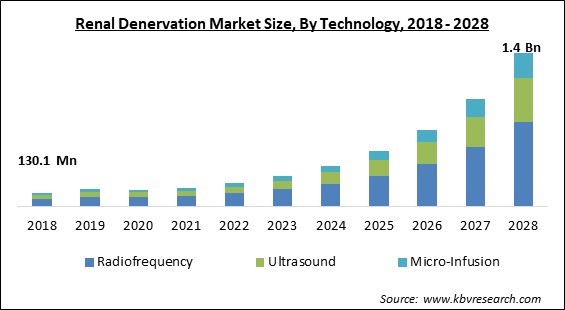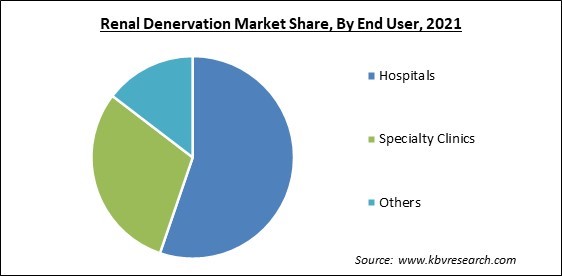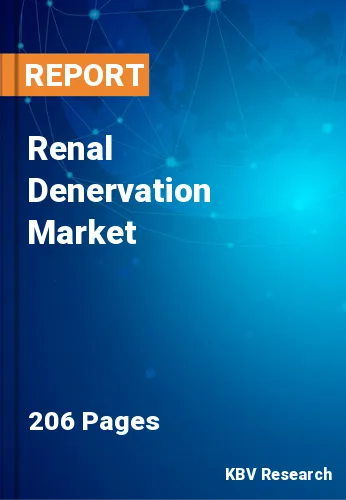The Global Renal Denervation Market size is expected to reach $1.4 billion by 2028, rising at a Market growth of 36.4% CAGR during the forecast period.
Renal denervation is a minimally invasive, catheter-based treatment for hypertension. The nerves in the renal arteries are burnt using radiofrequency ablation. Nerve activity is lowered, and blood pressure is reduced. When pharmacological treatment has failed to provide relief, this procedure is usually employed in order to obtain enhanced results. The nerves of the renal artery wall are ablated using radiofrequency pulses or ultrasound. This reduces blood pressure by lowering sympathetic kidney activity.
One of the key factors supporting Market growth is a significant rising prevalence of lifestyle diseases, like hypertension, due to an increase in the number of people who smoke and drink alcohol, sedentary and hectic lifestyles, increasing unhealthy dietary patterns, and the surging geriatric population. Apart from that, the RDN system's advantages, such as quick recuperation, safety, efficiency, and cost-effectiveness, are operating as a major growth-inducing element. Moreover, the rising demand for minimally invasive surgeries is fueling the Market 's expansion. In addition, micro-infusion technology, improved healthcare infrastructure, increased research and development activities, and an increase in the number of files for regulatory approvals of the systems are all contributing to Market expansion.
Ultrasound ablates nerves in the renal artery wall, interrupting nerve impulse transmission and decreasing blood pressure with ultrasound-based renal denervation devices. It is a hypertension treatment that is done with the least amount of invasiveness possible. Ultrasound-based technologies' significant efficacy in trials is anticipated to rise their relevance and rejuvenate them. For example, ReCor Medical, a medical device manufacturer, debuted Paradise Ultrasound Renal Denervation for the therapeutics of hypertension in October 2021. This minimally invasive renal denervation technology is used to treat excessive blood pressure. Hence, the significant number of benefits of this method along with the increasing efforts and initiatives being introduced by major Market players would accelerate the growth of the renal denervation Market throughout the coming years.

The COVID-19 pandemic caused a severe impact on various economies all over the world. Several businesses were significantly devastated as a result of the outbreak of the COVID-19 infection. In addition, the governments of several countries were forced to impose lockdowns in their nations. As a result, the manufacturing units of numerous goods were temporarily shut down. Moreover, these lockdowns also caused a major disruption in the supply chain of various goods. Further, COVID-19 led the worldwide healthcare industry to a significant failure due to the shortage of beds and oxygen in hospitals.
With the increasing modernization all over the world, the lifestyles of people are majorly being altered. The day-to-day routines of people worldwide are increasingly becoming hectic. Hypertension is a significant and modifiable risk factor for cardiovascular disorders and diseases, chronic kidney disease, and death. Because more strict BP objectives are recommended by guidelines, obtaining these targets frequently necessitates the use of multiple drugs, which can result in increased dosing complexity, expense, pill burden, and drug intolerance. There are few choices for treating hypertension without worsening polypharmacy or in the presence of multidrug intolerance.
The number of new capabilities that are being introduced in the renal denervation approach is one of the major factors that is accelerating its adoption. Renal denervation systems that incorporate ultrasound technology can overcome the limitations of radiofrequency-based renal denervation systems. The high-frequency sound waves of the ultrasonic energy aid to ablate nerves without coming into close touch with the tissues. This aids in the prevention of renal artery damage. Due to this attribute, a significant number of patients all over the world prefer this technology. Moreover, the integration of technology into these kinds of healthcare practices offers a considerable scale of enhancements in the outcomes of these techniques.
One of the major factors that are restricting the demand for renal denervation methods is the risk of infection that can be caused post a surgery. Any kind of surgery that involves cuts, incisions, or any other kind of invasion into the skin can cause infection in the body of the patient. Mostly, infections in surgical wounds are visible after one month of the surgery. Due to the post-surgical infection, various types of problems in the wound or in the body of the patient can occur. For example, surgical wound infections can ejaculate the puss from the incision. In addition, these infections are very painful and cause soars and inflammation in the wound.

Based on Technology, the Market is segmented into Radiofrequency, Ultrasound, and Micro-Infusion. In 2021, the Ultrasound segment witnessed a significant revenue share of the renal denervation Market . The ultrasound-based renal denervation devices employ ultrasound to ablate nerves in the walls of the renal arteries in a minimally invasive process. It reduces blood pressure by disrupting nerve impulse transmission to and from the kidney. Ultrasound energy in the form of high-frequency sound waves vaporizes nerves without making direct contact with tissues, minimizing renal artery damage. Due to the lesser damage to the renal artery in this method, the growth of the segment would significantly increase.
Based on End User, the Market is segmented into Hospitals, Specialty Clinics, and Others. In 2021, the Hospitals segment procured the largest revenue share of the real denervation Market . The government's increased investment in the construction of numerous specialty hospitals to combat the prevalence of dangerous diseases is boosting this segment's growth. Additionally, hospitals are mostly staffed by professional practitioners, nurses, surgeons, and associated health practitioners, whereas in the past, this labor was typically handled by founding religious orders or volunteers.
Based on Product Type, the Market is segmented into Symplicity, Enlightn, Vessix, Paradise, Iberis, and Others. In 2021, the simplicity segment procured the largest revenue share of the renal denervation Market . This device is most commonly used to treat hypertension because it delivers low-level radiofrequency energy, which reduces the risk of high-level radiofrequency causing radiation damage to body tissues. It also offers a minimally invasive method for treating high blood pressure. Due to the attribute that it causes lesser blood loss, the growth of this segment is estimated to flourish throughout the coming years.
| Report Attribute | Details |
|---|---|
| Market size value in 2021 | USD 169.9 Million |
| Market size forecast in 2028 | USD 1.4 Billion |
| Base Year | 2021 |
| Historical Period | 2018 to 2020 |
| Forecast Period | 2022 to 2028 |
| Revenue Growth Rate | CAGR of 36.4% from 2022 to 2028 |
| Number of Pages | 206 |
| Number of Tables | 379 |
| Report coverage | Market Trends, Revenue Estimation and Forecast, Segmentation Analysis, Regional and Country Breakdown, Companies Strategic Developments, Company Profiling |
| Segments covered | Product Type, Technology, End User, Region |
| Country scope | US, Canada, Mexico, Germany, UK, France, Russia, Spain, Italy, China, Japan, India, South Korea, Singapore, Malaysia, Brazil, Argentina, UAE, Saudi Arabia, South Africa, Nigeria |
| Growth Drivers |
|
| Restraints |
|
Based on Regions, the Market is segmented into North America, Europe, Asia Pacific, and Latin America, Middle East & Africa. In 2021, Asia-Pacific witnessed a significant revenue share of the renal denervation Market . In Asia-Pacific, due to a large number of unmet medical needs for hypertension therapy, increased knowledge of advanced technologies like renal denervation systems, and a high prevalence rate of resistant hypertension, there are numerous potential growth prospects for the Market players. Therefore, the regional Market would substantially grow throughout the coming years.
Free Valuable Insights: Global Renal Denervation Market size to reach USD 1.4 Billion by 2028
The Market research report covers the analysis of key stake holders of the Market . Key companies profiled in the report include Abbott Laboratories, Boston Scientific Corporation, Medtronic PLC, Ablative Solutions, Inc., Mercator MedSystems, Inc., ReCor Medical, Inc., Renal Dynamics Limited, Johnson & Johnson, and Terumo Corporation.
By Technology
By End User
By Product Type
By Geography
The renal denervation market size is projected to reach USD 1.4 billion by 2028.
Rising instances of hypertension among people are increasing are driving the market in coming years, however, risk of post-surgery infection growth of the market.
Abbott Laboratories, Boston Scientific Corporation, Medtronic PLC, Ablative Solutions, Inc., Mercator MedSystems, Inc., ReCor Medical, Inc., Renal Dynamics Limited, Johnson & Johnson, and Terumo Corporation.
The Radiofrequency segment acquired maximum revenue share in the Global Renal Denervation Market by Technology in 2021, thereby, achieving a Market value of $774.6 million by 2028.
The North America is the fastest growing region in the Global Renal Denervation Market by Region in 2021.
Our team of dedicated experts can provide you with attractive expansion opportunities for your business.

